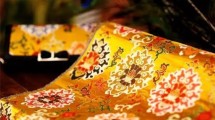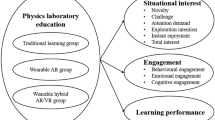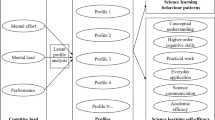Abstract
This study addresses whether augmented reality (AR)-based online wearable guides are better at improving learners’ situational interest (with regard to the fields of novelty, challenge, attention demand, exploration intention, instant enjoyment, and total interest) and learning achievement (remembering, understanding, and analyzing) compared with audio guides. This study employed a museum as its research site and examined a total of 96 participants who were randomly divided into two groups: one group using AR-based online wearable guides and the other using audio guides. In the experiment, both groups were required to complete a prior knowledge quiz, a scale of situational interest, and a test of learning achievement, as well as contributing post-activity open-format feedback. The results of this study indicate that situational interest and the remembering dimension of learning achievement have a significant and positive correlation, and that, when compared with the audio guide, the AR-based online wearable guide increased the learners’ situational interest and instant enjoyment, as well as the remembering dimension of learning performance. Therefore, the AR-based online wearable guide exhibits the ability to cultivate long-term interest in informal curricula. It is suggested that, when applying AR-based online wearable guides in informal curricula, content difficulty levels should be designed appropriately so that the learners’ instant enjoyment, situational interest, and content remembering performance would not be undermined.







Similar content being viewed by others
References
Hanko, K., Lee, S., Okeke, N.: What makes a great museum experience and how can technology help? http://www.sloverlinett.com/files/publications/Executivesummary-FieldMuseumvisitorexperienceandtechnologyresearch-SloverLinett.pdf (2014). 28 Mar 2016
Johnson, L., Becker, S.A., Estrada, V., Freeman, A.: NMC Horizon Report: 2015 Museum Edition. The New Media Consortium, Austin (2015)
Statista.: Facts and statistics on wearable technology. http://www.statista.com/topics/1556/wearable-technology/ (2015). 21 Dec 2015
Wall, D., Ray, W., Pathak, R.D., Lin, S.M.: A google glass application to support shoppers with dietary management of diabetes. J. Diabetes Sci. Technol. 8(6), 1245–1246 (2014)
Moshtaghi, O., Kelley, K.S., Armstrong, W.B., Ghavami, Y., Gu, J., Djalilian, H.R.: Using Google glass to solve communication and surgical education challenges in the operating room. Laryngoscope 125(10), 2295–2297 (2015)
Tully, J., Dameff, C., Kaib, S., Moffitt, M.: Recording medical students’ encounters with standardized patients using Google glass: providing end-of-life clinical education. Acad. Med. 90(3), 314–316 (2015)
Lieberman, J., Breazeal, C.: TIKL: development of a wearable vibrotactile feedback suit for improved human motor learning. IEEE Trans. Robot. 23(5), 919–926 (2007)
MIT Media Lab.: What’s a wearable? http://www.media.mit.edu/wearables/ (2015). 13 Dec 2015
Johnson, L., Becker, S.A., Estrada, V., Freeman, A.: NMC Horizon Report: 2015 Higher Education Edition. The New Media Consortium, Austin (2015)
Brophy, P., Butters, G.: Creating a research agenda for local libraries, archives and museums across Europe. New Rev. Inf. Netw. 13(1), 3–21 (2007)
Tehrani, K., Michael, A.: Wearable technology and wearable devices everything you need to know. http://www.wearabledevices.com/what-is-a-wearable-device/ (2014). 27 Mar 2016
Leue, M.C., Jung, T., Tom Dieck, D.: Google glass augmented reality: generic learning outcomes for art galleries. In: Tussyadiah, I., Inversini, A. (eds.) Information and Communication Technologies in Tourism 2015, pp. 463–476. Springer, New York (2015)
Chen, A., Darst, P.W., Pangrazi, R.P.: What constitutes situational interest? Validating a construct in physical education. Meas. Phys. Educ. Exerc. Sci. 3(3), 157–180 (1999)
Hidi, S., Renninger, K.A.: The four-phase model of interest development. Educ. Psychol. 41(2), 111–127 (2006)
Carliner, S.: Modeling information for three-dimensional space: lessons learned from museum exhibit design. Tech. Commun. 50(4), 554–570 (2003)
Chang, K.E., Chang, C.T., Hou, H.T., Sung, Y.T., Chao, H.L., Lee, C.M.: Development and behavioral pattern analysis of a mobile guide system with augmented reality for painting appreciation instruction in an art museum. Comput. Educ. 71, 185–197 (2014)
Mayer, R.E.: Instruction based on visualizations. In: Mayer, R.E., Alexander, P.A. (eds.) Handbook of Research on Learning and Instruction, pp. 427–445. Routledge, New York (2011)
Rhodes, B.J.: The wearable remembrance agent: a system for augmented memory. Pers. Technol. 1(4), 218–224 (1997)
Juan, C., Beatrice, F., Cano, J.: An augmented reality system for learning the interior of the human body. In: International Conference on Advanced Learning Technologies (2008)
Westerfield, G., Mitrovic, A., Billinghurst, M.: Intelligent augmented reality training for motherboard assembly. Int. J. Artif. Intell. Educ. 25(1), 157–172 (2015)
Tsai, C.W., Shen, P.D., Fan, Y.T.: The application of augmented reality in online education: a review of studies published in selected journals from 2003 to 2012. Int. J. Inf. Commun. Technol. Educ. 10(2), 75–80 (2014)
Di Serio, Á., Ibáñez, M.B., Kloos, C.D.: Impact of an augmented reality system on students’ motivation for a visual art course. Comput. Educ. 68, 586–596 (2013)
Bacca, J., Baldiris, S., Fabregat, R., Graf, S.: Augmented reality trends in education: a systematic review of research and applications. J. Educ. Technol. Soc. 17(4), 133–149 (2014)
Radu, I.: Augmented reality in education: a meta-review and cross-media analysis. Pers. Ubiquitous Comput. 18(6), 1533–1543 (2014)
Damala, A., Cubaud, P., Bationo, A., Houlier, P., Marchal, I.: Bridging the gap between the digital and the physical: design and evaluation of a mobile augmented reality guide for the museum visit. In: 3rd International Conference on Digital Interactive Media in Entertainment and Arts (2008)
Carmigniani, J., Furht, B., Anisetti, M., Ceravolo, P., Damiani, E., Ivkovic, M.: Augmented reality technologies, systems and applications. Multimed. Tools Appl. 51(1), 341–377 (2011)
Vainstein, N., Kuflik, T., Lanir, J.: Towards using mobile, head-worn displays in cultural heritage: user requirements and a research agenda. In: 21st International Conference on Intelligent User Interfaces (2016)
Google: Google I/O 2014. https://www.google.com/events/io/schedule (2014). 10 Aug 2016
Hasan, M.S., Yu, H.: Innovative developments in HCI and future trends. In: 21st International Conference on Automation and Computing (2015)
Riera, A.S., Redondo, E., Fonseca, D.: Geo-located teaching using handheld augmented reality: good practices to improve the motivation and qualifications of architecture students. Univers. Access Inf. Soc. 14(3), 363–374 (2015)
Krapp, A., Hidi, S., Renninger, K.A.: Interest, learning, and development. In: Renninger, K.A., Hidi, S., Krapp, A. (eds.) The Role of Interest in Learning and Development, pp. 3–26. Lawrence Erlbaum Associates, Hillsdale (1992)
Ainley, M.: Being and feeling interested: transient state, mood, and disposition. In: Schutz, P.A., Pekrun, R. (eds.) Emotions in Education, pp. 147–163. Academic Press, Cambridge (2007)
Linnenbrink Garcia, L., Durik, A.M., Conley, A.M., Barron, K.E., Tauer, J.M., Karabenick, S.A., Harackiewicz, J.M.: Measuring situational interest in academic domains. Educ. Psychol. Meas. 70(4), 647–671 (2010)
Deci, E.L.: The relation of interest to the motivation of behavior: a self-determination theory perspective. In: Renninger, K.A., Hidi, S., Krapp, A. (eds.) The Role of Interest in Learning and Development, pp. 43–69. Lawrence Erlbaum Associates, Hillsdale (1992)
Chen, A., Darst, P.W., Pangrazi, R.P.: An examination of situational interest and its sources in physical education. Br. J. Educ. Psychol. 71(3), 383–400 (2001)
Rowe, J.P., Shores, L.R., Mott, B.W., Lester, J.C.: Integrating learning, problem solving, and engagement in narrative-centered learning environments. Int. J. Artif. Intell. Educ. 21(1), 115–133 (2011)
Sun, J.C.Y., Rueda, R.: Situational interest, computer self-efficacy and self-regulation: their impact on student engagement in distance education. Br. J. Educ. Technol. 43(2), 191–204 (2012)
Hsinchu City Cultural Affairs Bureau: A View of the Past: The Years of Military Communities in Images. Hsinchu City Cultural Affairs Bureau, Hsinchu (1997). (in Chinese)
Hsinchu City Cultural Affairs Bureau: Collection of Armed Forced Dependents’ Villages Museum in Hsinchu. Hsinchu City Cultural Affairs Bureau, Hsinchu (2004). (in Chinese)
Hsinchu City Cultural Affairs Bureau: Love for the Military Dependents Village: A Land-Use Survey for Cultural Characteristics of the Hsinchu Military Community. Hsinchu City Cultural Affairs Bureau, Hsinchu (2009). (in Chinese)
Hsinchu City Government: What Happened Under the Smokestack. Hsinchu City Government, Hsinchu (2014). (in Chinese)
Anderson, L.W., Krathwohl, D.R., Airasian, P.W., Cruikshank, K.A., Mayer, R.E., Pintrich, P.R., Raths, J., Wittrock, M.C.: A Taxonomy for Learning, Teaching, and Assessing: A Revision of Bloom’s Taxonomy of Educational Objectives, Abridged Edition, 1st edn. Pearson, Cambridge (2001)
Ebel, R.L., Frisbie, D.A.: Essentials of Educational Measurement, 3rd edn. Prentice Hall, Upper Saddle River (1979)
Ahmann, J.S., Glock, M.D.: Evaluating Student Progress: Principles of Tests and Measurements, 6th edn. Allyn and Bacon, Boston (1981)
Acknowledgements
This research was supported by the Ministry of Science and Technology in Taiwan through Grant Nos. MOST 105-2511-S-009-013-MY5, MOST 104-3011-E-194-001-, and MOST 104-3011-E-194-002-. The authors would like to thank the staff from the Hsinchu City Military Dependents’ Village Museum, NCTU’s ILTM (Interactive Learning Technology and Motivation) Lab members, the students who participated in this study, Meng-Han Li, Chih-Ting Chen, Jui-Ping Lu, Chin-Kun Yu, Shih-Ching Yu, Yu-Chen Chen, Hsiu-Shan Lin, Hsueh-Er Tsai, Pei-Hsun Hsieh, Yu-Ling Chen, and Yi-Chuan Hsu for their assistance in conducting the experiment, Sunny S. J. Lin for her valuable suggestions, and all of the reviewers for their useful comments.
Author information
Authors and Affiliations
Corresponding author
Rights and permissions
About this article
Cite this article
Yu, SJ., Sun, JY. & Chen, OC. Effect of AR-based online wearable guides on university students’ situational interest and learning performance. Univ Access Inf Soc 18, 287–299 (2019). https://doi.org/10.1007/s10209-017-0591-3
Published:
Issue Date:
DOI: https://doi.org/10.1007/s10209-017-0591-3




